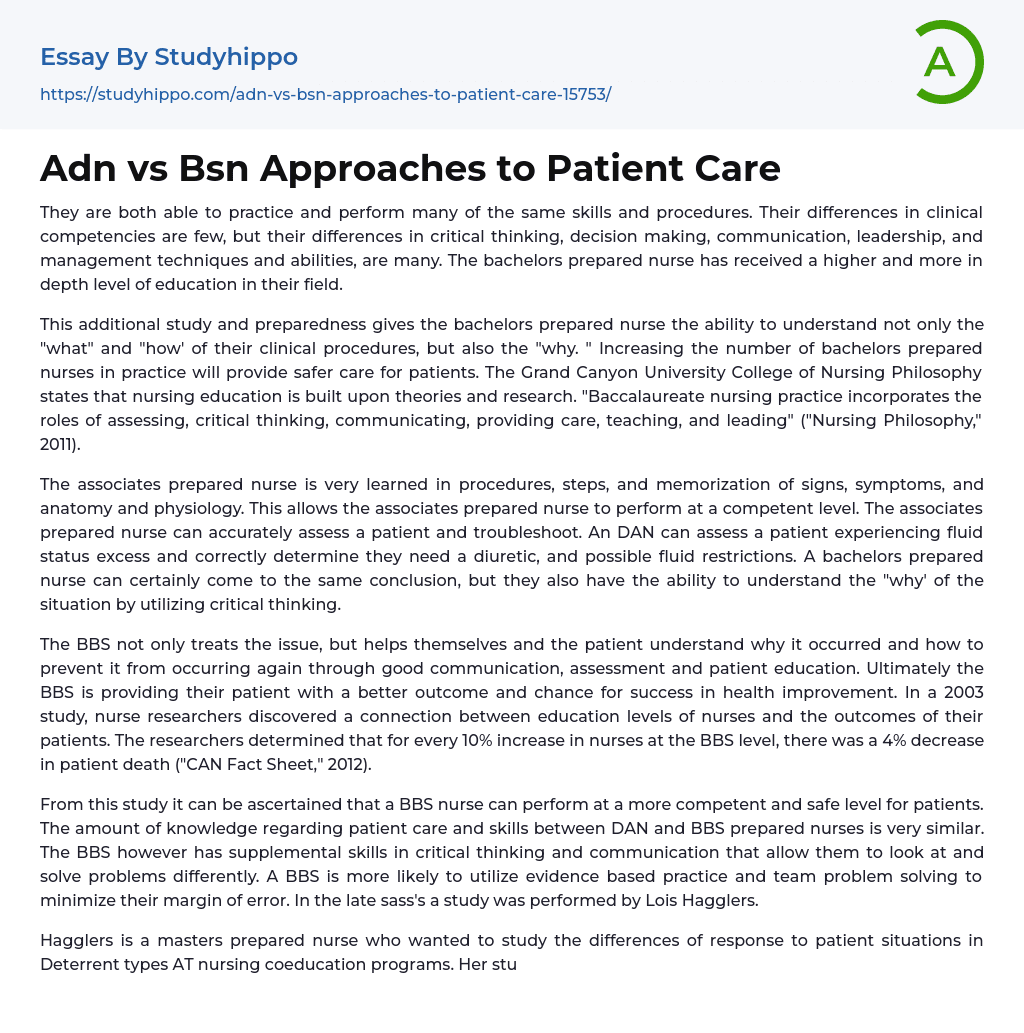They are both able to practice and perform many of the same skills and procedures. Their differences in clinical competencies are few, but their differences in critical thinking, decision making, communication, leadership, and management techniques and abilities, are many. The bachelors prepared nurse has received a higher and more in depth level of education in their field.
This additional study and preparedness gives the bachelors prepared nurse the ability to understand not only the "what" and "how' of their clinical procedures, but also the "why. " Increasing the number of bachelors prepared nurses in practice will provide safer care for patients. The Grand Canyon University College of Nursing Philosophy states that nursing education is built upon theories and research. "Baccalaureate nursing practice incorporates the roles of assessing, critical thinking, communicating, providing care, teaching, and leading"
...("Nursing Philosophy," 2011).
The associates prepared nurse is very learned in procedures, steps, and memorization of signs, symptoms, and anatomy and physiology. This allows the associates prepared nurse to perform at a competent level. The associates prepared nurse can accurately assess a patient and troubleshoot. An DAN can assess a patient experiencing fluid status excess and correctly determine they need a diuretic, and possible fluid restrictions. A bachelors prepared nurse can certainly come to the same conclusion, but they also have the ability to understand the "why' of the situation by utilizing critical thinking.
The BBS not only treats the issue, but helps themselves and the patient understand why it occurred and how to prevent it from occurring again through good communication, assessment and patient education. Ultimately the BBS is providing their patient with a better outcome and chanc
for success in health improvement. In a 2003 study, nurse researchers discovered a connection between education levels of nurses and the outcomes of their patients. The researchers determined that for every 10% increase in nurses at the BBS level, there was a 4% decrease in patient death ("CAN Fact Sheet," 2012).
From this study it can be ascertained that a BBS nurse can perform at a more competent and safe level for patients. The amount of knowledge regarding patient care and skills between DAN and BBS prepared nurses is very similar. The BBS however has supplemental skills in critical thinking and communication that allow them to look at and solve problems differently. A BBS is more likely to utilize evidence based practice and team problem solving to minimize their margin of error. In the late sass's a study was performed by Lois Hagglers.
Hagglers is a masters prepared nurse who wanted to study the differences of response to patient situations in Deterrent types AT nursing coeducation programs. Her study prompted a puss Tort more search on this issue and for the increase in baccalaureate prepared nurses. The study began with 44 DAN and 31 BBS students preparing to graduate. They were presented with four case studies. They watched two videos of patients expressing somatic distress and two videos of patients expressing non-somatic distress. They were prompted to fill out a questionnaire for each scenario stating what they would say first to each patient.
Hagglers discovered that both the DAN and BBS responses to the patients experiencing physical pain were similar and focused on exploring the cause, length, type, and severity of the pain. The responses
to the patients experiencing emotional distress differed greatly. The DAN students responses focused on assumptions, inference, false reassurance, and action suggestions such as, "Try to relax. " The BBS responses were focused on open ended questions to enhance patient-nurse communication, specific comments based on observations from the patient, and asking patient questions to empower them in their distressful situations.
Headgear's study showed that there was a difference in the way DAN and BBS prepared nurses are taught to respond in patient situations, and that DAN orgasm focus more on somatic patient situations and BBS programs focus greatly on both types (Hagglers, 1987). In conclusion the baccalaureate level of education provides nurses with higher communication and assessment skills that give them more opportunities to verbally explore distressed behaviors and create a more effective patient-nurse relationship.
Although both the DAN and the BBS can perform the same clinical skills and procedures, the bachelors prepared nurse is able to understand what occurred in the patient that required the procedure and why they are performing that specific procedure. The bachelors prepared nurse is keel to have a smaller margin of error in their practice than the associates prepared nurse, and this will have a positive effect on patient care and nursing practice in the future.
- Academia essays
- Higher Education essays
- Language Learning essays
- Studying Business essays
- Education System essays
- Study essays
- First Day of School essays
- Scholarship essays
- Pedagogy essays
- Curriculum essays
- Coursework essays
- Studying Abroad essays
- Philosophy of Education essays
- Purpose of Education essays
- Brainstorming essays
- Educational Goals essays
- Importance Of College Education essays
- Brown V Board of Education essays
- The Importance Of Higher Education essays
- Online Education Vs Traditional Education essays
- Academic And Career Goals essays
- Academic Integrity essays
- Brown Vs Board Of Education essays
- Distance learning essays
- Technology in Education essays
- Vocabulary essays
- Writing Experience essays
- Importance of Education essays
- Early Childhood Education essays
- Academic Degree essays
- Academic Dishonesty essays
- School Uniform essays
- Academic writing essays
- Cheating essays
- Bachelor's Degree essays
- MBA essays
- College Life essays
- Grade essays
- Diploma essays
- Phonology essays
- Sentence essays
- Filipino Language essays
- Pragmatics essays
- Millennium Development Goals essays
- History Of Education essays
- Graduate School essays
- Middle School essays
- School essays
- Special Education essays
- University essays




